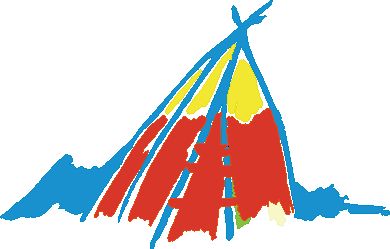Preparing the good life: Children learning traditional food habits
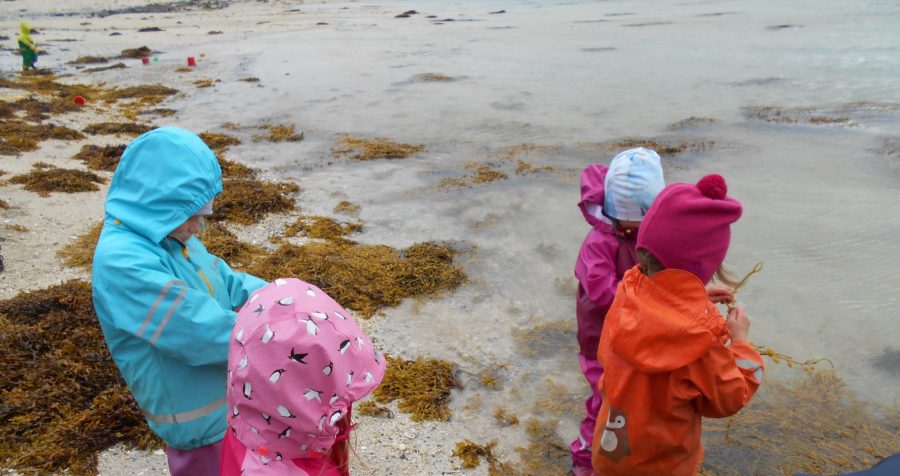
Background
Ten Sámi kindergarten children from 3 to 5 years old are out in typical Northern Norway never-ending pouring rainy weather in late June to pick raw plant materials for today’s lunch. Today, the kids are going to make nettle soup and in order to fulfil the task, they have to go out and pick the nettle. They have to know where to pick, how the nettle plant looks like, where it grows, and not least when in the annual circle it grows and can be picked. They also need to know that you have to wear gloves because the nettle plant “bites” sharply. Indoors again, the children have to clean and rinse their nettle catch. They learn that only the leaves are to be used and these must be finely chopped and cooked. When the soup was done, it was served with boiled organic eggs. The appetite was great around the lunch table.
As the example above shows, they are learning – in the practical way – about traditional Sámi food as a part of their day in the kindergarten.
The Sámi is an indigenous people with traditional settlements in the Arctic and sub-Arctic; Norway, Sweden, Finland and Russia. The territory traditionally inhabited of the Sámi people is called Sápmi. The name comes from the Sámi’s own term for themselves, for instance saemie, sámit or sápmelaččat. The Arctic and sub-Arctic areas are known for a harsh climate without too high temperatures, long snowy winters and short rainy summers. With the everlasting light (and midnight sun) in summers, the growing season is short, but intense. To live and survive in such an environment give some challenges when it comes to food choices.
Like the majority population in the four nation states, the Sámi have witnessed and taken part in modernization of society. New lifestyles have been integrated, where technology and globalization have made household activities easy and international trade ware accessible in a monetary economy. Leaving the traditional way of living and harvesting, has as one of its unfortunate consequences that many Sámi have a lifestyle very alien to the traditional way of life. Also, competence related to traditional food products is vanishing. Still some Sámi are in the fisheries, the reindeer industry, agriculture and rural economies, but most Sámi are paycheck receivers in ordinary jobs in for instance education, administration and service.
Many traditions have been left in favor of modern practices, where households have gone from producers of necessary food products to consumers, even if parts of the very old hunting-gathering traditions still are practiced. Going fishing or hunting for wild game, or picking berries and herbs, as a supplement to shops’ assortment of daily goods, are practiced. Essentially, food is bought at the store, and few children learn about the production chain ahead of finding the goods in the store shelves.
It is common for both parents in a current household / family to have paid employment and thus the children spend the day in kindergarten and school. The parental temptation for serving their children semi-finished dishes bought in the shop out of lack of time and energy is present after busy workdays. The consequences are that lifestyle illnesses like high blood pressure, obesity and diabetes become more and more common. To change this “modern” curse, the kindergarten in cooperation with the parents, decided to take responsibility for maintaining and disseminating traditional knowledge and practices in food and nutrition.
Objectives
Márkomának is a Sami kindergarten in Evenes Municipality in Nordland County. The kindergarten in cooperation with the parents, wanted the children to be introduced to traditional knowledge and practices in food and nutrition. They started a programme to teach the children about traditional food – all the way from putting the seed in the ground until the food was served on the table.
How it was done
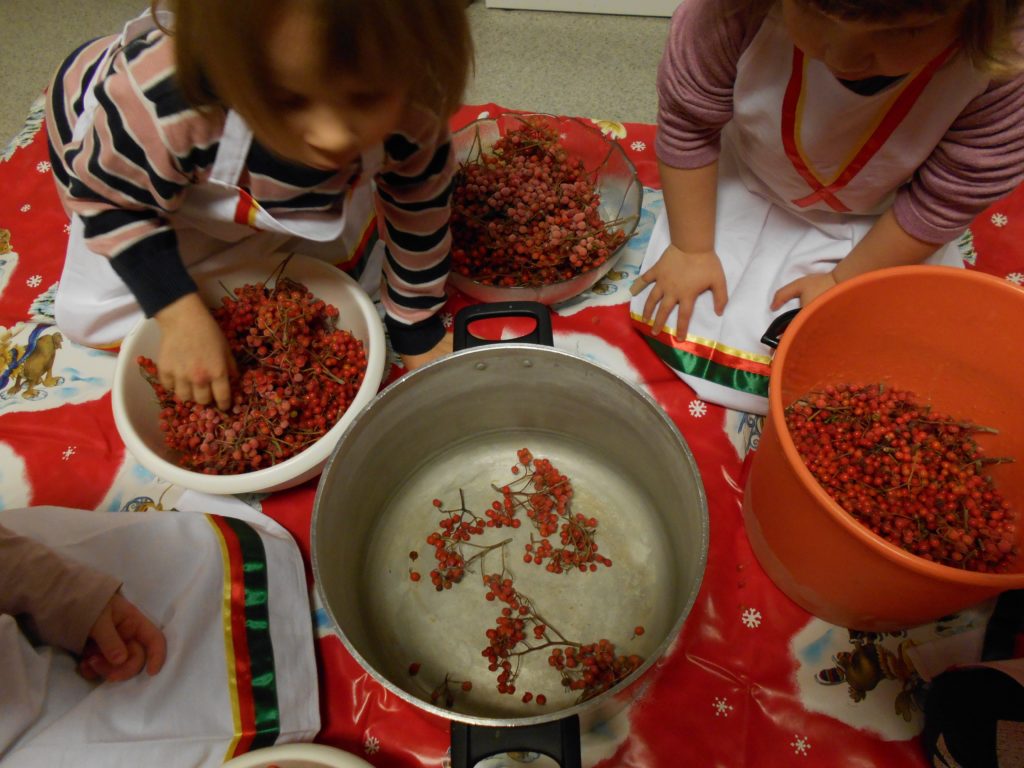
Making Rowanberry jelly. Photo, Janne Olsby.
The focus was on transmission of traditional knowledge about food and the food chain process from raw materials from nature to cooked dishes served on the table to the young generation and give them examples of good and healthy traditional food.
This article will look into the importance of transmission of traditional knowledge about food and the food chain process from raw materials from nature to cooked dishes served on the table to the young generation and highlight some examples of good and healthy traditional food.
The nettle soup is such an example. Nettle is one of the first green plants in spring (late May). It contains a lot of vitamins and minerals that everyone is in need of after a long harsh winter. Nettle has also traditionally been used as a medicine plant for different inflammations. The children learned that they had easy access to nettle plants – they grow around every house in the village, especially where the soil is rich.
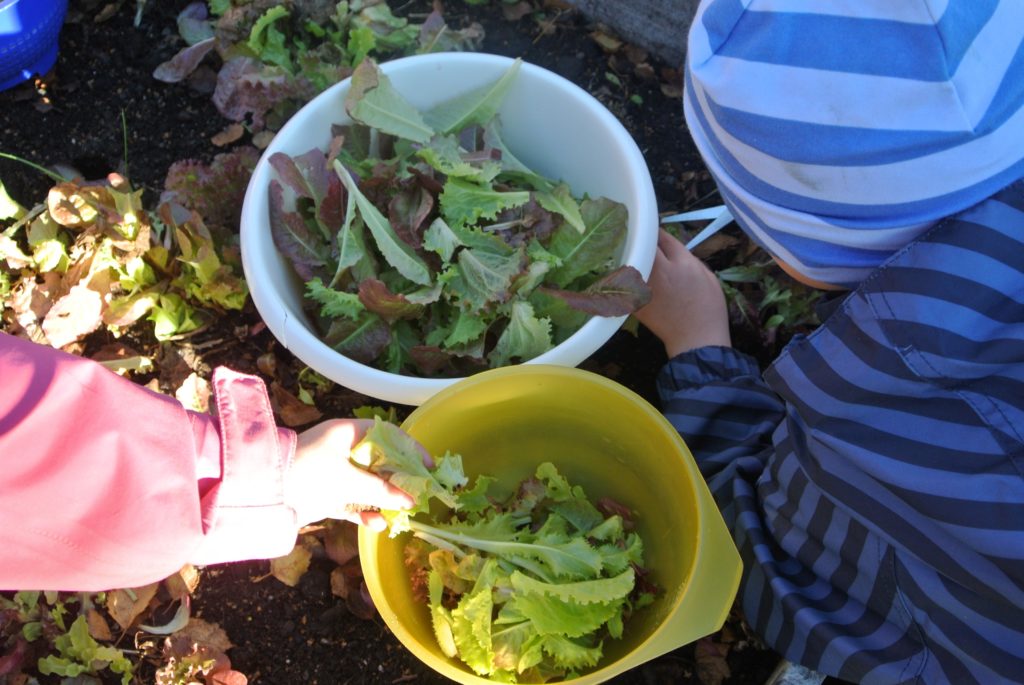
Harvesting Lettuce. Foto, Janne Olsby
Another green plant that comes early in spring and grows everywhere is dandelions. It is common to use the leaves in salads. In the kindergarten, the children learned about the interconnection between weather conditions and harvesting when they decided to make cookies with the dandelions’ flowers as an ingredient. Because of several weeks with rain, the flowers did not fold out and were impossible to use. The children looked for the dandelions every day, but had to give up picking “closed” flowers, and by that making dandelion cookie.
Potatoes and vegetables like carrots and turnips have traditionally been grown for a long time, being able to ripe before the autumn frost nights arrive. The children learned about the production process, from seed to harvested plant. Furthermore, the children learned that vegetables do not grow in the shop shelves, but in the fields, and they need a lot of caring during the whole growing-season. After harvest, the children discovered that their vegetables were much smaller than the shop’s goods, which came from the southern parts of Norway and the Mediterranean area. This gave the opportunity to teach the children about different needed factors for making plants grow, like temperatures and sun-hours during the day.
When talking about traditional Sámi food, one considers local products, either berries/greenery/ vegetables or local wild game/birds/salt- and sweet water-fish. It consists of both animal and vegetarian food produced or hunted in the children’s immediate natural environment. In order to learn about harvesting, gathering, picking and other methods, the child must be present in the situation where knowledge and practice from master to apprentice are transmitted and disseminated. Why, for instance, should you be quiet when fishing in a lake? Could it be that if you frighten the fish, it will disappear to the (mythological) lake underneath the visible lake? Alternatively, why should you not scream and shout when going berry picking? Could it be that phenomena in nature will hide the berries if you do not respect the invisible inhabitants? In addition, why is it important to remember to say thank you before going home with your catch? In this way, learning about harvesting of nature, the apprentice also learns about the traditional Sámi worldview and how to respect and honor nature as the giver of the food.
Commodities and foods that are focused on in this article are rarely found in the store shelves. The children had to go out in nature and gather / pick the berries and herbs themselves, or visit the fishing boat, the reindeer slaughterhouse or the agricultural farmyard to find the raw materials needed for a traditional diet. Food is not just for eating or non-starving; it is also medicine and health. The traditional food made from animal blood was earlier on everyone’s table especially in the fall after slaughtering, filled up the mineral and iron depots in the body. Traditional food also contains less salt and sugar than a modern diet. Traditional dishes with animal blood as the main ingredient were also a part of the kindergarten children’s “curriculum”. Having a reindeer slaughterhouse in one of the neighboring villages, the whole group of children could visit when it was time for the autumn slaughtering. The main goal for the visit was to teach the children that almost everything of the animal could be used for food, clothes and utensils. The blood is a part of this. In agriculture, with sheep and other domesticated animals, it also is the tradition that almost the whole animal is used. The blood can be part of part of a good nutritious diet. It does not contain fat and sugar. However, on the other hand, it is a good protein source and contains much iron. In addition, this is cheap food. Half a liter of blood is needed to make dinner for four grown-ups. After having fetched blood at the slaughterhouse, the children learned the whole process of making traditional dishes like blood-balls and blood-pancakes. The blood-balls were served with potatoes, lingonberries and a tiny bit of syrup, while the blood-pancakes were served with syrup. This became one of the children’s favorite dishes.
Before in-door electricity and not least before the freezer became a common furniture, the blood was stored in different ways. In pre-modern time, people built houses and barns close to a river because they had to carry all the water to the house and barn. A usual conservation method was to keep the blood in barrels submerged in cold running water. In the winter the blood would freeze, so when they needed it for food, they took a knife and cut off a block. In listening to narratives like these, the children get to know and understand their great-grandparents’ lives where there were no running water or electricity in the houses. Water had to be carried and wood for heating and cooking had to be chopped – and all this was hard and time-consuming work. The installation of running water and electricity in houses was a true revolution for the household. The children experienced when they were hiking in the low mountains how to live and make dishes the very traditional way. To be able to prepare the reindeer meat they had brought for food, they needed to learn how to make a fire by collecting firewood, how to set fire to it and where it should for safety be located. To learn how to master both a knife and matches is crucial in a traditional way of life.
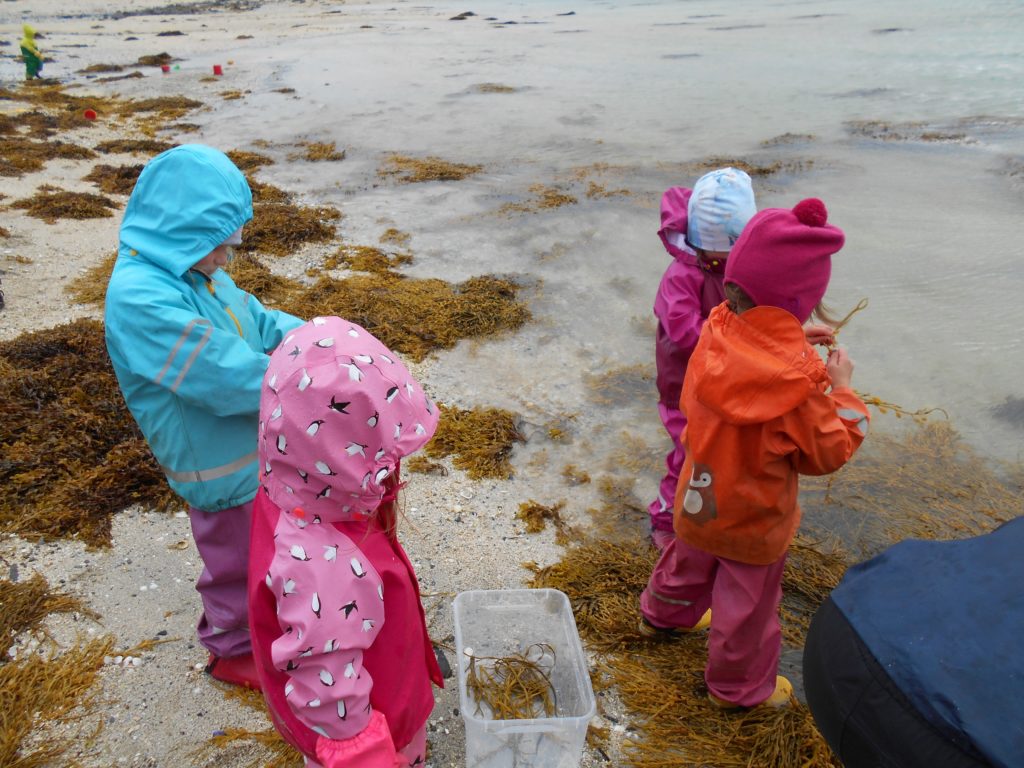
Gathering seaweed. Photo, Janne Olsby.
Living on the coast, close to the sea and with plenty of lakes in the inland area, fish has been one of the main choices of food. Every year if possible, due to weather conditions, the children go on fishing trips to both salt and sweet water. Fish that they catch become dissected and subject to thorough investigation. Fish are not toys or pets. Fish is food and should not be played with. The children have made fish cakes and fish burgers of fresh haddock fillet. It is important to teach the children that with proper equipment it is easy to fetch fish, as well as learning how to master the fishing equipment. The children also go fishing in a nearby narrow river. This year they got a large trout, but when gutting it, they discovered that it was full of worms and thus inedible. This inspired a long and reflexive conversation about manmade contamination and environmental pollution, and how to turn around such a development.
Conclusion
The kindergarten programme on teaching the children about traditional Sámi food became an overall positive experience. The children became fond of making traditional dishes, and they have become conscious about the interdependence between people and nature for survival and keeping in good health. Furthermore, the children’s Sámi language skills and repertoire improved, and they have learned Sámi terms on both raw materials and the different ingredients in the finished dishes. As such, the programme has also contributed to language revitalization. It was important for the staff at the kindergarten that the children should have a good time while being introduced to traditional food. Learning responsibility and participating in co-determination was part of the programme. As a participant, the children were chefs with hats, aprons, their own utensils as well as their own project folder. Among other things, individual responsibility for good hygiene is important.
A very positive effect of the programme has been that traditional Sámi dishes has become a larger part of the children’s families’ daily food. As one child said with a smile: “Because it tastes good! It is the best food ever!”
References
Márkománák (2017) Project description: Healthy food habits from an early age.
Várjjat Sámi Musea: http://www.saivu.com (downloaded 01.06.2019)
Falk, E and Park, S: Traditional Food, Sharing experiences from the Field” (2019) ICHCAP and #HeritageAlive, Living Heritage series, Jeonju
The article was first published in the book “Traditional Food, Sharing experiences from the Field” by ICHCAP and #HeritageAlive, ed. Falk and Park), in 2019
Key factors
1. Positive experience.
When learning traditional skills to children, it is important that the children have a good time and enjoy themselves, to give a positive experience.
2. The teaching methods are practical
The children were learning by participating in all aspects of food gathering and preparation.
3. Cooperation
The programme was organized in cooperation between the kindergarten and the parents.
4. Transmission of knowledge
Learning and transmission of knowledge from the older generation with experience (master) to the children (apprentice). In this way, they learned both practical skills and oral traditions. The programme also contributed to language revitalization.

